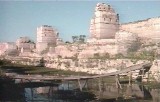 The
Land Walls
The
Land Walls
 The
Land Walls
The
Land Walls
The defensive
system added by Theodosius II in the early fifth century combined two
lines of defense with a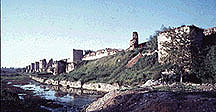 moat. They are perhaps the
moat. They are perhaps the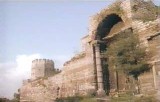 most
significant work of military architecture to come down to us from
the Middle Ages. The repairs, additions, inscriptions, and
modifications to the walls comprise a dramatic history of the city.
They were kept in constant repair throughout the Middle Ages, only to
fall to the cannons of Mehmet II in 1453 and,
most
significant work of military architecture to come down to us from
the Middle Ages. The repairs, additions, inscriptions, and
modifications to the walls comprise a dramatic history of the city.
They were kept in constant repair throughout the Middle Ages, only to
fall to the cannons of Mehmet II in 1453 and, 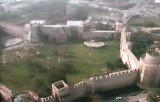 more
recentlry, to heavy-handed restorations. The restorations were
financed in part by
more
recentlry, to heavy-handed restorations. The restorations were
financed in part by 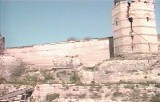 UNESCO,
but the exigencies of the municipal authority caused the project to
be rushed. The work was divided among eleven contractors, with a
"scientific consultant" assigned to each, when one could be
located. In most areas, the walls have been overrestored and refaced.
Perhaps they now give a clearer idea of how the elaborate defensive
system once worked, but
UNESCO,
but the exigencies of the municipal authority caused the project to
be rushed. The work was divided among eleven contractors, with a
"scientific consultant" assigned to each, when one could be
located. In most areas, the walls have been overrestored and refaced.
Perhaps they now give a clearer idea of how the elaborate defensive
system once worked, but 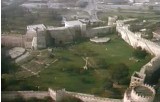 all
sorts of historical
all
sorts of historical 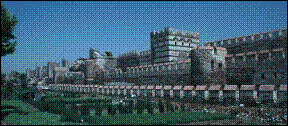 evidence
was destroyed in the process. There does not appear to be any
coordination between teams, nor a plan for the publication of the
results. With the change of government in 1994, the work was abruptly
halted. A report
evidence
was destroyed in the process. There does not appear to be any
coordination between teams, nor a plan for the publication of the
results. With the change of government in 1994, the work was abruptly
halted. A report 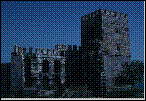 on
the restoration of the southernmost section (Towers 1-6) has
recently been published by M. Ahunbay. The so-called Marble Tower,
near the end of the Land Walls at the Sea of Marmara, has been
recently identified by U. Peschlow as a Palaiologan residence.
Devices associated with the Palaiologos and Cantacuzenos families
were noted on the cornices.
on
the restoration of the southernmost section (Towers 1-6) has
recently been published by M. Ahunbay. The so-called Marble Tower,
near the end of the Land Walls at the Sea of Marmara, has been
recently identified by U. Peschlow as a Palaiologan residence.
Devices associated with the Palaiologos and Cantacuzenos families
were noted on the cornices.